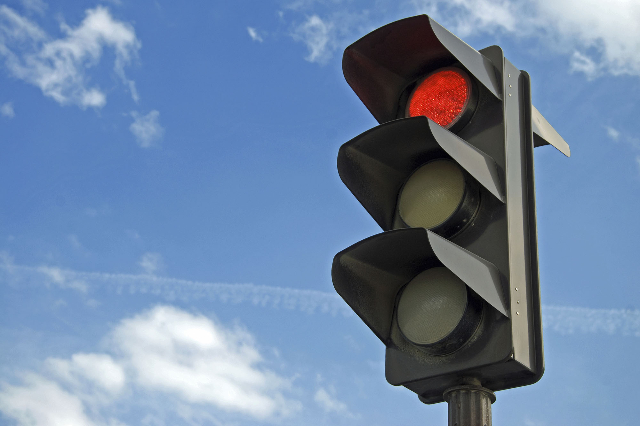Reflective tape new tool to battle red-light runners in Vegas

It’s a danger we’re all too familiar with, not only on Southern Nevada streets, but on roads nationwide: the red-light runner.
According to the Federal Highway Administration, nearly 900 people are killed nationwide every year in intersection accidents resulting from motorists running red lights.
A number of organizations have come up with countermeasures to reduce the running of red lights, including traffic signal software modifications to lengthen signal change intervals and the installation of traffic cameras that capture the license plate numbers of red-light runners.
Red-light runner victims and their families are angered most by the motorist who blasts through a signal just because they’re running late and figure they won’t get caught.
But there are motorists that sail through a red light because they don’t see the signal. There’s a countermeasure first tried in South Carolina that has found its way to Southern Nevada and noted by alert Warrior reader Allan:
“I was driving on Rancho Drive near U.S. Highway 95. I noticed that all of the traffic signals for north- and southbound traffic are now surrounded with a yellow (reflective?) frame. It obviously is to make the signals themselves stand out against their respective backgrounds.
“What is the history behind this and is this only a test or will we be seeing this addition all over the valley? I would also be curious if there have been any studies on the effectiveness of such things in reducing traffic accidents. On the surface it seems like a great idea.”
City of Las Vegas transportation officials agree with you, Allan.
From city Transportation Manager Mike Janssen: “The reflective frames are actually a 24-month pilot test for Southern Nevada using a one-time federal-fund grant. As part of the recently completed Rancho Corridor Intelligent Transportation System Project, which installed new fiber-optic cable communication lines along Rancho between Sahara Avenue and Rainbow Boulevard to improve communication to the traffic signal systems along the corridor, the city of Las Vegas also installed these traffic signal back-plate high-visibility borders.”
Janssen said the borders were found by the Federal Highway Administration to increase driver compliance to a traffic signal and improve safety in large part because the signals are more visible, particularly at night, and they also helped reduce red-light running.
The South Carolina Department of Transportation is credited with first installing 3-inch reflective yellow tape on traffic signal back plates. The tape installation cost $1,500 per intersection and took two hours per intersection to complete.
South Carolina reported in 2005 after first installing the tape that accidents were reduced at three test intersections from between 19.7 percent and 38.9 percent and that late night-early morning crashes were down between 31.8 percent and 85.5 percent.
It’s a great idea to reduce the number of crashes due to motorists not seeing the light.
Now, all we have to do is figure out how to stop the knuckleheads who blast through red lights because they feel like it.
Bad job?
Warrior reader Nicholas and his neighbors are a little upset with the poor job pavers have done in his neighborhood:
“I live between Maryland Parkway and Spencer Street, Tropicana and Hacienda avenues and a lot of homeowners like myself are very upset and have complained to the city for the terrible road work that was recently done in our neighborhood. The crew came in to fix the road, but all the cracks they had to seal are just more visible. It’s like a giant came down with a huge black marker and had some fun.
“The city refuses to come out to fix it or even look at it. There are spills of asphalt and the mess has lowered the value of our homes. Many people have sold and left and we’re about to do the same. It’s a shame that taxpayers are taken advantage of so badly.”
Don’t worry, Nicholas, help is on the way.
First things first. If you called the city — i.e., the city of Las Vegas — you probably would have been told this is a Clark County project. Because the city, the county and the state oversee various streets and roadways in Las Vegas, it’s sometimes a little difficult to figure out who to call to scream at.
This project is actually a two-step fix and only the first step has been completed.
“Crack sealing is the first step in road maintenance to promote road longevity,” said Clark County spokesman Dan Kulin. “When you fill in the cracks, it helps keep the road from deteriorating more and strengthens it.”
Crack-sealing roads also prepares them for the next step.
“We also crack seal roads in preparation for a road slurry seal, which is a new top layer on the pavement,” he said. “The slurry seal will cover the lines.”
Kulin said Nicholas’ neighborhood is scheduled for a slurry seal sometime next year.
Questions and comments should be sent to roadwarrior@reviewjournal.com. Please include your phone number. Follow the Road Warrior on Twitter: @RJroadwarrior